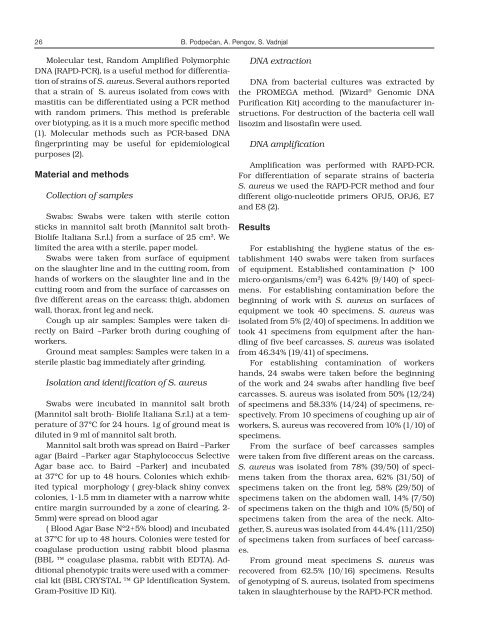Slov Vet Res 2007; 44 (1/2) - Slovenian veterinary research
Slov Vet Res 2007; 44 (1/2) - Slovenian veterinary research
Slov Vet Res 2007; 44 (1/2) - Slovenian veterinary research
Create successful ePaper yourself
Turn your PDF publications into a flip-book with our unique Google optimized e-Paper software.
26<br />
B. Podpečan, A. Pengov, S. Vadnjal<br />
Molecular test, Random Amplified Polymorphic<br />
DNA (RAPD-PCR), is a useful method for differentiation<br />
of strains of S. aureus. Several authors reported<br />
that a strain of S. aureus isolated from cows with<br />
mastitis can be differentiated using a PCR method<br />
with random primers. This method is preferable<br />
over biotyping, as it is a much more specific method<br />
(1). Molecular methods such as PCR-based DNA<br />
fingerprinting may be useful for epidemiological<br />
purposes (2).<br />
Material and methods<br />
Collection of samples<br />
Swabs: Swabs were taken with sterile cotton<br />
sticks in mannitol salt broth (Mannitol salt broth-<br />
Biolife Italiana S.r.l.) from a surface of 25 cm 2 . We<br />
limited the area with a sterile, paper model.<br />
Swabs were taken from surface of equipment<br />
on the slaughter line and in the cutting room, from<br />
hands of workers on the slaughter line and in the<br />
cutting room and from the surface of carcasses on<br />
five different areas on the carcass; thigh, abdomen<br />
wall, thorax, front leg and neck.<br />
Cough up air samples: Samples were taken directly<br />
on Baird –Parker broth during coughing of<br />
workers.<br />
Ground meat samples: Samples were taken in a<br />
sterile plastic bag immediately after grinding.<br />
Isolation and identification of S. aureus<br />
Swabs were incubated in mannitol salt broth<br />
(Mannitol salt broth- Biolife Italiana S.r.l.) at a temperature<br />
of 37°C for 24 hours. 1g of ground meat is<br />
diluted in 9 ml of mannitol salt broth.<br />
Mannitol salt broth was spread on Baird –Parker<br />
agar (Baird –Parker agar Staphylococcus Selective<br />
Agar base acc. to Baird –Parker) and incubated<br />
at 37°C for up to 48 hours. Colonies which exhibited<br />
typical morphology ( grey-black shiny convex<br />
colonies, 1-1.5 mm in diameter with a narrow white<br />
entire margin surrounded by a zone of clearing, 2-<br />
5mm) were spread on blood agar<br />
( Blood Agar Base N°2+5% blood) and incubated<br />
at 37°C for up to 48 hours. Colonies were tested for<br />
coagulase production using rabbit blood plasma<br />
(BBL coagulase plasma, rabbit with EDTA). Additional<br />
phenotypic traits were used with a commercial<br />
kit (BBL CRYSTAL GP Identification System,<br />
Gram-Positive ID Kit).<br />
DNA extraction<br />
DNA from bacterial cultures was extracted by<br />
the PROMEGA method. (Wizard ® Genomic DNA<br />
Purification Kit) according to the manufacturer instructions.<br />
For destruction of the bacteria cell wall<br />
lisozim and lisostafin were used.<br />
DNA amplification<br />
Amplification was performed with RAPD-PCR.<br />
For differentiation of separate strains of bacteria<br />
S. aureus we used the RAPD-PCR method and four<br />
different oligo-nucleotide primers OPJ5, OPJ6, E7<br />
and E8 (2).<br />
<strong>Res</strong>ults<br />
For establishing the hygiene status of the establishment<br />
140 swabs were taken from surfaces<br />
of equipment. Established contamination (> 100<br />
micro-organisms/cm 2 ) was 6.42% (9/140) of specimens.<br />
For establishing contamination before the<br />
beginning of work with S. aureus on surfaces of<br />
equipment we took 40 specimens. S. aureus was<br />
isolated from 5% (2/40) of specimens. In addition we<br />
took 41 specimens from equipment after the handling<br />
of five beef carcasses. S. aureus was isolated<br />
from 46.34% (19/41) of specimens.<br />
For establishing contamination of workers<br />
hands, 24 swabs were taken before the beginning<br />
of the work and 24 swabs after handling five beef<br />
carcasses. S. aureus was isolated from 50% (12/24)<br />
of specimens and 58.33% (14/24) of specimens, respectively.<br />
From 10 specimens of coughing up air of<br />
workers, S. aureus was recovered from 10% (1/10) of<br />
specimens.<br />
From the surface of beef carcasses samples<br />
were taken from five different areas on the carcass.<br />
S. aureus was isolated from 78% (39/50) of specimens<br />
taken from the thorax area, 62% (31/50) of<br />
specimens taken on the front leg, 58% (29/50) of<br />
specimens taken on the abdomen wall, 14% (7/50)<br />
of specimens taken on the thigh and 10% (5/50) of<br />
specimens taken from the area of the neck. Altogether,<br />
S. aureus was isolated from <strong>44</strong>.4% (111/250)<br />
of specimens taken from surfaces of beef carcasses.<br />
From ground meat specimens S. aureus was<br />
recovered from 62.5% (10/16) specimens. <strong>Res</strong>ults<br />
of genotyping of S. aureus, isolated from specimens<br />
taken in slaughterhouse by the RAPD-PCR method.
















